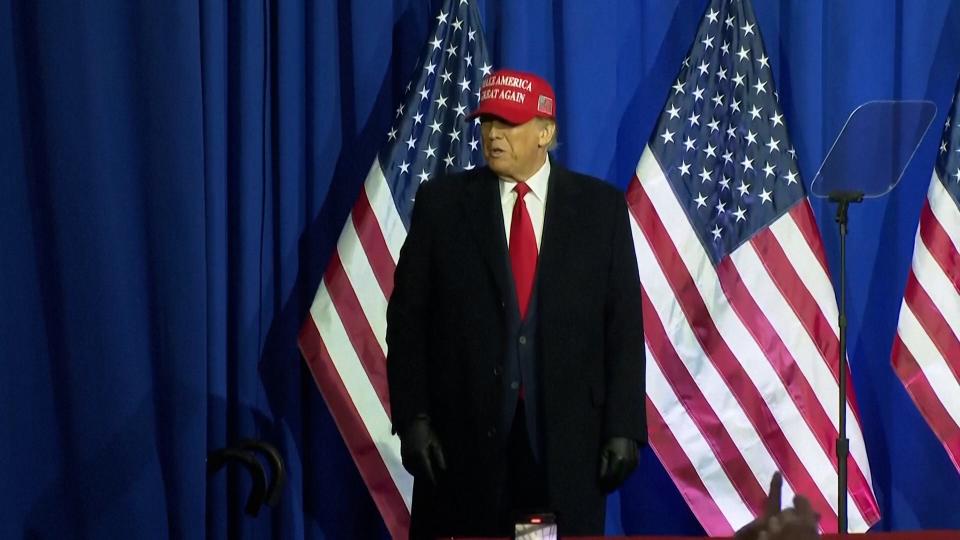Trump, Biden square off on border in Texas. Why they could have come to Arizona
- Oops!Something went wrong.Please try again later.
- Oops!Something went wrong.Please try again later.
- Oops!Something went wrong.Please try again later.
President Joe Biden and former President Donald Trump set up dueling visits to the Texas-Mexico border on Thursday as immigration and border security once again take center stage ahead of the anticipated November rematch between the presumed White House nominees.
Biden, a Democrat, will visit Brownsville, a border city of about 200,000 residents at the southmost tip of Texas, where he will meet with border agents and push the need for bipartisan legislation to address the situation at the southern U.S. border.
In recent weeks, the White House has taken a tougher approach to border security and has considered taking executive action after a border deal with Republicans that he signed off on — and was crafted in part by Sen. Kyrsten Sinema, I-Ariz. ― failed in the Senate.

Trump will visit Eagle Pass, a community of 30,000 residents south of San Antonio. He is once again making immigration and border security a cornerstone of his campaign, hoping that his continued attacks on Biden's border policies will carry him to another term in the White House.
Eagle Pass is at the center of a legal showdown between the Biden administration and Texas Gov. Greg Abbott over border enforcement. Abbot took control of a local park from the U.S. Border Patrol and has deployed National Guard troops, razor wire and buoys on the Rio Grande, accusing Biden of not enforcing U.S. immigration laws.

How many migrants are at the US-Mexico border?
In January, the U.S. Border Patrol recorded 124,220 crossings between ports of entry along the southwestern border, a 50% drop from December, which saw record-high migration, according to the Washington Office on Latin America.
In January, CBP processed approximately 45,000 individuals through appointments at ports of entry made through the CBP One application, a mobile government application to book appointments to request entry into the U.S.
The Washington Office on Latin America speculated that the reasons for the sharp drop in migration in January could be rumors circulating among migrants about a year-end border closure or halt in CBP One appointment at ports of entry; the colder weather; or a crackdown by Mexican government forces.
Migrant encounters have risen sharply at the U.S.-Mexico border since 2020 when the COVID-19 pandemic and lockdowns virtually halted all border crossings. For the past two years, Customs and Border Protection has logged more than 2 million encounters.
The Biden administration has relied on using humanitarian parole to process and release thousands of migrants and asylum seekers each day at the border, since the federal government has limited detention capacity. The use of this parole authority has come under withering criticism from Republicans.
What is the situation at the Arizona border?
In the past year, the Arizona border became the busiest migrant crossing route along the entire southern U.S. border. The area near the Lukeville border crossing, about 115 miles south of Phoenix, was the epicenter of that increase in migrant arrivals.
The numbers so overwhelmed border agents at the Organ Pipe Cactus National Monument that in December, Customs and Border Protection shut down the Lukeville port of entry for a month to redirect officers to help process hundreds of migrants crossing through gaps in the border fence at the national monument.
The Tucson Sector had the highest number of crossings compared to other sectors on the southwestern border in fiscal year 2024. The Tucson Sector covers the western two thirds of the Arizona border from the New Mexico State line to the Yuma County line. Agents stationed there encountered 250,611 migrants from October to January, according to data from U.S. Customs and Border Protection.
Historically, the number of migrants attempting to cross through the Arizona border decreases in January and February, but then begins to rise as temperatures warm up along the Sonoran Desert.
Will Congress pass any bills this year addressing the border?
In early February, a bipartisan agreement in the Senate that would have restricted asylum at the border in exchange for providing military aid to Ukraine, Israel and other U.S. allies flopped when Republicans, led by Trump, scorched the deal.
That is the closest that Congress has gotten to finally addressing border security in more than a decade. But the chances of passing compromise border or immigration bills through a divided Congress decrease as the November elections approach.
Sinema was one of three senators involved in the four-month-long negotiations that included the White House and Senate leadership from both parties. When the $118 billion deal fizzled this month, Sinema excoriated her fellow senators accusing them of all talk and no action when it comes to border issues.
Other lawmakers have introduced their own proposals to address border security. House Republicans passed a partisan bill known as H.R. 2 that includes nonstarters for Democrats like resuming border wall construction, gutting the asylum system, and restricting a president's parole authority. The bill has no chance of passing the Democratic-controlled Senate.
Rep. Greg Stanton, D-Ariz., also unveiled an immigration reform framework this month as part of the centrist New Democrats Coalition. It would provide a pathway to citizenship to some undocumented immigrants living in the country, like farmworkers and Dreamers. The American Immigration Council said the bill has little chance of passing, but could be used to help shape future agreements.
This article originally appeared on Arizona Republic: Biden, Trump visit Texas border; Arizona remains busiest for crossings

